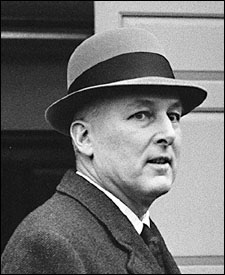Nathan Marsh Pusey
Faculty of Arts and Sciences – Memorial Minute
At a Meeting of the Faculty of Arts and Sciences December 14, 2004, the following Minute was placed upon the records.
It is easy in the world to live after the world’s opinion.
It is easy in solitude to live after your own;
But the great man is he who, in the midst of the crowd,
Keeps with perfect sweetness the independence of solitude.
Ralph Waldo Emerson
On the afternoon of October 13, 1953, Nathan Marsh Pusey was installed in this room as the twenty-fourth president of Harvard College, inducted into office by Judge Charles Wyzanski, Jr. ’27, president of the Board of Overseers. The new president pledged to “try to keep assembled here the best scholars and teachers that can be found, to work to ensure conditions conducive to their best efforts, and constantly to strive for more effective ways to make their activity touch, quicken, and strengthen the intellectual aspirations of succeeding generations of young people.” He concluded with these words: “Harvard is a great intellectual enterprise founded and nourished in great faith. It shall be my purpose, continuing in that faith, to guide it as best I can, so help me God.”

Nathan Marsh Pusey was born on April 4, 1907, in Council Bluffs, Iowa. He entered the College in the Class of 1928; in his senior year he was elected to Phi Beta Kappa; and he graduated with a degree in English, magna cum laude. In 1937 he took a doctorate in the Classics. Mr. Pusey was Harvard’s first president to be born in the twentieth century, the first from west of the Mississippi River, and the first to have taken the Ph.D. degree from this faculty.
After his first teaching appointment at Scripps College in California, Mr. Pusey taught at Wesleyan University and then at Lawrence College in Wisconsin, where from 1944 to 1953 he served as president. During those years he gained a reputation as a good administrator and skillful fundraiser, yet in Cambridge he was relatively unknown. When his election became public at the time of his Twenty-fifth reunion in June 1953, the buzz among his classmates was “Pusey? Who’s he?”
One person who had known him and did not like him was the junior senator from Wisconsin, Joseph McCarthy. They had sparred, and would spar again, but Mr. Pusey, already known for independent thought and courage under fire, was not easily intimidated and commented that some people could not distinguish between red and crimson.
The early years of the Pusey administration were marked by the ubiquity of the youthful but experienced president, who was accustomed to direct involvement in faculty affairs. This stood in marked contrast to the latter years of the Conant administration, when by reason of national service the president had been less immediately engaged in matters of administration and instruction. Routinely, President Pusey took the chair at meetings of this faculty, and at least once each year he did so in all of the graduate and professional schools. Regarding the making of permanent faculty appointments as his most significant responsibility, the president took his prerogatives seriously and chaired every Ad Hoc Committee in this faculty.
Writing early in his long retirement, Mr. Pusey characterized the period from 1944 to 1971 as “the most creative yet experienced in the ongoing development of higher education in the United States.” Higher education in those years enjoyed great public favor. Early in his presidency, Mr. Pusey initiated the first and largest modern capital campaign, entitled ‘The Program for Harvard College,’ whose enormous success made possible an expansion of resources and a building boom not seen since the Lowell era. When asked why he built so many tall buildings, the president answered, simply, “We had no place to go but up.”
Attacked from the right at the beginning of his presidency, Mr. Pusey endured attacks from the left towards its end, yet neither intimidated nor embittered him. Often, to the consternation of both admirers and critics, he maintained an equanimity, even a serenity, that he was not ashamed to ascribe to his careful reading in Roman history, Greek philosophy, and Christian theology.
To some, his quiet but conspicuous Christianity seemed out of step with the secular ideologies of modernity, yet his appeal to faith was neither sentimental nor exclusive, and his commitment to the reality of his own faith led him to take seriously the faith of others. Both the Divinity School and the Center for the Study of World Religions represented his conviction that the rigorous and sympathetic study of faith had a legitimate place within the academy. When Harvard awarded him an honorary degree at Commencement 1972, the citation read:
“Patient teacher, man of faith, for eighteen years
our generous president;
farsighted, compassionate, courageous:
through his leadership the capacities of Harvard
were larger and our nation’s high goals
for education confirmed.”
In 1936, Nathan Pusey married Anne Woodward, with whom he had three children. At that same Commencement in 1972, and in a marked departure from tradition, the University also conferred an honorary degree upon Anne Pusey, for reasons manifest in her citation, which read:
“Gracious and radiant lady, devoted wife and mother,
her friendly concern for the families of Harvard
made a true partnership of the presidency.”
On November 14, 2001, Nathan Pusey died in New York City, in the ninety-fifth year of his age; on July 20, 2004, Anne Pusey died, also in New York City, in her ninety-first year. An era well known to many of us has come to an end, and yet the legacy of this Harvard presidency is the continuing vitality of the institution that he pledged to cherish and to nourish. If you seek his memorial, look around you.
Respectfully submitted,
Derek Bok
Neil Rudenstine
Peter J. Gomes, Chairman




